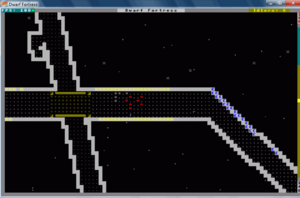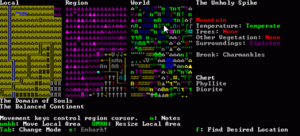- v50 information can now be added to pages in the main namespace. v0.47 information can still be found in the DF2014 namespace. See here for more details on the new versioning policy.
- Use this page to report any issues related to the migration.
Difference between revisions of "40d:Site"
(Fixing links within namespace (790/997)) |
|||
| Line 1: | Line 1: | ||
{{av}} | {{av}} | ||
| − | :''See | + | :''See {{L|location}} for information about the placement of fortresses in Fortress Mode.'' |
| − | '''Sites''' are artificial or inhabited features in the | + | '''Sites''' are artificial or inhabited features in the {{L|world}}. They're notable for being named individually and for being referred to in {{L|adventurer mode}} {{L|quest}}s. |
Note: Specific information about buildings is based on observation in adventure mode and may be incomplete or outdated | Note: Specific information about buildings is based on observation in adventure mode and may be incomplete or outdated | ||
| Line 10: | Line 10: | ||
Token: CITY | Token: CITY | ||
| − | Wooden house cities. Have shops, temples and | + | Wooden house cities. Have shops, temples and {{L|mayor}}al houses. |
Represented by {{Tile|+|#777|#000}}, {{Tile|*|#777|#000}}, {{Tile|☼|#777|#000}}, and {{Tile|#|#777|#000}} on the world map. | Represented by {{Tile|+|#777|#000}}, {{Tile|*|#777|#000}}, {{Tile|☼|#777|#000}}, and {{Tile|#|#777|#000}} on the world map. | ||
| Line 46: | Line 46: | ||
Token: CAVE_DETAILED | Token: CAVE_DETAILED | ||
| − | Ornate | + | Ornate {{L|underground}} structures. |
Structure: | Structure: | ||
| Line 65: | Line 65: | ||
Token: CAVE | Token: CAVE | ||
| − | Underground, presumably natural mazes. Occupied by subterranean | + | Underground, presumably natural mazes. Occupied by subterranean {{L|creatures}} such as {{L|giant cave spider}}s and {{L|large rat}}s, and often occupied by {{L|megabeasts}} or {{L|kobold}} civilizations. |
Represented by {{Tile|•|#777|#000}} on the world map. | Represented by {{Tile|•|#777|#000}} on the world map. | ||
| Line 79: | Line 79: | ||
Token: DARK_FORTRESS | Token: DARK_FORTRESS | ||
| − | Cities made of above-ground towers of smoothed natural | + | Cities made of above-ground towers of smoothed natural {{L|obsidian}}. May feature temples. may be occupied by an Invader force. |
Structures: | Structures: | ||
| Line 85: | Line 85: | ||
**Towers can have a basement level with a connection to a tunnel just like Mountain Halls. | **Towers can have a basement level with a connection to a tunnel just like Mountain Halls. | ||
* Temple. (This _may_ follow the same template as Human temples - the size and the pool at the bottom certainly match.) 20x20 interior. | * Temple. (This _may_ follow the same template as Human temples - the size and the pool at the bottom certainly match.) 20x20 interior. | ||
| − | **Observed: | + | **Observed: {{L|rutile}} block floor and natural [!] {{L|gabbro}} engraved wall. 2F/3B/R connected by ramps. Pool in last basement. All walls engraved some engraved floors outside. 4 tile dirt ring around outside ground (observed white sand). |
Represented by {{Tile|П|#707|#000}} on the world map. | Represented by {{Tile|П|#707|#000}} on the world map. | ||
| Line 92: | Line 92: | ||
[[Image:Tunnel crossing chasm.png|thumb|right|An underground tunnel crossing a chasm via a bridge. Antmen, naked mole dogs, and other creatures are visible to the right. This tunnel connected a couple of goblin fortresses together.]] | [[Image:Tunnel crossing chasm.png|thumb|right|An underground tunnel crossing a chasm via a bridge. Antmen, naked mole dogs, and other creatures are visible to the right. This tunnel connected a couple of goblin fortresses together.]] | ||
[[Image:Tunnel in local view.png|thumb|right|A tunnel emanating from a dark fortress, as seen in the local view.]] | [[Image:Tunnel in local view.png|thumb|right|A tunnel emanating from a dark fortress, as seen in the local view.]] | ||
| − | Some mountain halls and dark fortresses have a staircase down at the bottom level, leading to a narrow hallway to another (possibly multi-level) single staircase down to a (walls/floor not smoothed except immediately around the staircase) 7-wide tunnel leading ultimately to another site. Hostile creatures can be found in these tunnels near sites or chasm crossings, and they vary in Z-level, with ramps up or down across the full width of the tunnel ( | + | Some mountain halls and dark fortresses have a staircase down at the bottom level, leading to a narrow hallway to another (possibly multi-level) single staircase down to a (walls/floor not smoothed except immediately around the staircase) 7-wide tunnel leading ultimately to another site. Hostile creatures can be found in these tunnels near sites or chasm crossings, and they vary in Z-level, with ramps up or down across the full width of the tunnel ({{L|orthogonal}}/diagonal transitions near z-level transitions sometimes cause slightly narrower ramps). There are bridges over chasms; these are 5 wide made of floors (Phyllite block even though the surrounding stone was Gabbro) and constructed walls at each side and a 3-tile approach at each end. The one I observed was open to a small cave in the side of the chasm which was, presumably, the source of the {{L|antman|antmen}} and {{L|ratman|ratmen}} the tunnel was infested with. The route of the tunnel seemed much more circuitous than it should be to connect between the two sites in question. You cannot Travel while in a tunnel. <!-- too long for here; may be useful in a split-out article - Traversing the tunnel (between two sites ___ map tiles apart), my adventurer became thirsty four times / dehydrated (ran out of water, so had to wait for it to let me drink disgusting things) once, hungry twice, drowsy twice. I ate when hungry, drank when thirsty, slept when drowsy. --> |
| − | [SHOW_EMBARK_TUNNEL:ALWAYS] has to be set in | + | [SHOW_EMBARK_TUNNEL:ALWAYS] has to be set in {{L|init.txt}} for tunnels to be visible on the local map, as pictured at right. They will usually curve around other underground features (chasms, rivers, etc.), except when this is not possible through a given local section, in which case they will cross the other feature(s) via a bridge. |
<br clear="all" /> | <br clear="all" /> | ||
== Roads == | == Roads == | ||
Revision as of 16:51, 12 April 2010
| This article is about an older version of DF. |
- See Template:L for information about the placement of fortresses in Fortress Mode.
Sites are artificial or inhabited features in the Template:L. They're notable for being named individually and for being referred to in Template:L Template:Ls.
Note: Specific information about buildings is based on observation in adventure mode and may be incomplete or outdated
Towns/Cities
Token: CITY
Wooden house cities. Have shops, temples and Template:Lal houses.
Represented by +, *, ☼, and # on the world map.
Built on a "pseudo-grid pattern"; i.e. the site is divided into 81 16x16 grid spaces, and each such space only contains one building (keeps, temples, etc occupy more than one square). Buildings show up on a site map as they are discovered.
All structures made of constructed wooden floors. Keep has block walls and floors, other buildings have log walls/floors.
Structures:
H- House.- Hovel. 3x3 interior, constructed wood, bed, barrel containing a large amount of food, table, 3 chairs.
- Apartment building. 6 identical 4x3 rooms coming off of one central hallway. Total interior dimensions 11x11. Each room has bed/barrel/table/3xchair. Usually one floor; but can have two, three, or even more in crowded cities. Stairs are directly inside the door.
*- Shop. 7x7 interior, constructed wood. 10 tables, each table contains several buyable items, 1 chest, contains coins. Tile on site map varies to show type of shop.M- Mead Hall. Two stories, 12x12 interior. 1F: 5 beds, 4 tables, 8 chairs. 2F (mezzanine) - 1 wide pathway from ramp, then 3-wide shelf on next wall with 2 tables, 4 chairs.K- Keep. Large rectangle (observed 44x44), 2F/Roof, connected by stairs. Double doors, two chairs by far wall from door on ground floor. Usually wood blocks; stone keeps have been observed.T- Temple. Interior 20x20. Open 2-wide entrance.- Observed: 2 floors, Outside is a 4-tile ring of floors with haphazardly placed pillars. There is a 3-wide balcony on the second floor. No basement.
- Observed: Open-air at ground level, ring of chalk block floors with pillars at regular intervals supporting a ring as a second floor. Misc chalk floors inside the ring, otherwise dirt, with a large square of open space. B1: Dug into dirt, still open space at center. B2: More dirt, more open space. B3: Still dirt, pool of water in center. Pool coincides with the open-air hole. (The walls of the pool happen to be magnetite; I'm not convinced this is significant)
- Observed: One floor, ramp up to wide roof (i.e. accessible roof _plus_ the width that has been balconies on other temples). Overhang supported by regularly spaced pillars at ground level. Whole thing made of flint blocks (may be same religion as first observation above?) Nothing interesting in B1, pool in B2.
- Observed: Open-air ground level, some engraved floors and a siltstone block ring. Walls at corners, ramp up to 1-tile ring at second level.
- Observed: Ring of flint block floors outside, natural [!] flint engraved walls. 1 floor, accessible roof, two basements, pool (inside 2-wide border of floor) in lowest basement. Floor and walls of pool are block/engraved just as rest of temple.
Buildings have ramps down towards the doors or pillars below them down to the ground where necessary when built on uneven terrain. When built into a hill they will sometimes have wooden structures on the roof to hold up the ground above them.
Forest retreats
Token: TREE_CITY
Represented by î and ¶ on the world map.
Elf and Dwarf civ forest retreats contain no buildings, and are just a bunch of elves standing around.
Human civ forest retreats can contain the same buildings as a human town and are generally indistinguishable except for being on a forest instead of plains.
Mountain halls
Token: CAVE_DETAILED
Ornate Template:L structures.
Structure:
- Only one structure present on site. Large underground structure (not fully explored) of natural smoothed stone, characterized by 5x5 rooms, floors connected with wide ramps.
- Entryway
- Entry is from above - Top level (at highest outside terrain) is a 2-tile ring of floors and then a 1-tile ring of down stairs, surrounding empty space. Arbitrary number of floors down to lowest outside terrain: 2-tile ring of walls (walls are either smooth or block depending on whether they could logically be natural) and 1-tile ring of up-down stairs. 42x42 exterior dimensions at surface.
- Roof
- Roof at first natural non-soil level (as observed, was one level below lowest outside natural terrain where sand was present) consists of smoothed natural stone floors and one wide ramp (6 tiles wide) down at center.
- Interior
- Larger than implied by the outside structure. Interior mostly characterized by 2-wide hallways and 5x5 rooms, entirely of smoothed natural stone. Rooms in 2x2 blocks, and around edges. Each room has an aperture (no door) into all adjacent hallways. Rooms within blocks are separated by double walls.
- Placement of ramps to next floor vary but down ramps are generally near up ramps. Ramps are always N/S oriented (i.e. travel east or west to go up or down) and the down ramp is on the inside of a square arrangement of pillars, it is entered from the outside edge of the square nearest it
- King was located in a room on one site entry, on the entry way on another - so it looks like his positioning is random.
Represented by Ω on the world map.
Caves
Token: CAVE
Underground, presumably natural mazes. Occupied by subterranean Template:L such as Template:Ls and Template:Ls, and often occupied by Template:L or Template:L civilizations.
Represented by • on the world map.
Ruins
Token: RUIN
Destroyed buildings of other sites. Furniture is gone. Some walls remain walls even when there are no adjacent walls; others are pillars. A keep was observed intact in a Human ruin (are there ruins of mountain halls, dark fortress, etc?)
Represented by µ on the world map.
Dark fortresses
Token: DARK_FORTRESS
Cities made of above-ground towers of smoothed natural Template:L. May feature temples. may be occupied by an Invader force.
Structures:
- Tower. Several are present in a site. 40x40 interior, Height varies up to at least 5F/R, staircases. Entirely made of smoothed natural obsidian floors and walls. Haphazard interior wall placement. Roof lined with fortifications. Appears as
Пon site map.- Towers can have a basement level with a connection to a tunnel just like Mountain Halls.
- Temple. (This _may_ follow the same template as Human temples - the size and the pool at the bottom certainly match.) 20x20 interior.
- Observed: Template:L block floor and natural [!] Template:L engraved wall. 2F/3B/R connected by ramps. Pool in last basement. All walls engraved some engraved floors outside. 4 tile dirt ring around outside ground (observed white sand).
Represented by П on the world map.
Tunnels
Some mountain halls and dark fortresses have a staircase down at the bottom level, leading to a narrow hallway to another (possibly multi-level) single staircase down to a (walls/floor not smoothed except immediately around the staircase) 7-wide tunnel leading ultimately to another site. Hostile creatures can be found in these tunnels near sites or chasm crossings, and they vary in Z-level, with ramps up or down across the full width of the tunnel (Template:L/diagonal transitions near z-level transitions sometimes cause slightly narrower ramps). There are bridges over chasms; these are 5 wide made of floors (Phyllite block even though the surrounding stone was Gabbro) and constructed walls at each side and a 3-tile approach at each end. The one I observed was open to a small cave in the side of the chasm which was, presumably, the source of the Template:L and Template:L the tunnel was infested with. The route of the tunnel seemed much more circuitous than it should be to connect between the two sites in question. You cannot Travel while in a tunnel.
[SHOW_EMBARK_TUNNEL:ALWAYS] has to be set in Template:L for tunnels to be visible on the local map, as pictured at right. They will usually curve around other underground features (chasms, rivers, etc.), except when this is not possible through a given local section, in which case they will cross the other feature(s) via a bridge.
Roads
Human towns and cities are sometimes connected via a network of roads. Dirt roads are represented by a black line, smoothed roads by a light gray line, block roads by a white line.[Verify]
Caravans / "creatures"
Not strictly a site, these move around the map in adventure mode.
Structures:
- Bunch of civ members standing around.
Represented by (some tile, looks like a light gray horizontal line?) on the world map.
| [hide]
Worlds | |
|---|---|
Badlands · Desert · Flatland · Forest · Glacier · Lake · Marsh · Mountain · Murky pool · Ocean · River · Rocky wasteland · Sand desert · Swamp · Tundra |



